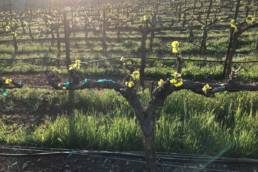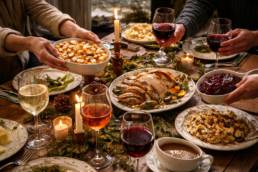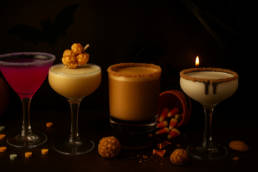FMN – July 2019 – Patriotic Wining
We are well into the summer and with Independence Day looming, preparations must be made in order to have a proper celebration. For some, this means spending hundreds of dollars on cardboard tubes filled with gunpowder, then consuming mass quantities of alcohol while blowing things up. Don’t get me wrong, I’ve been that guy and had loads of fun (and still have all my fingers). This year, however, I wanted to honor the risks taken by our forefathers by throwing something that had parents on my grill and drinking wine grown and made right here in the good old U.S. of A.
Granted, if I was a true wine patriot, I would consume wine from each and every state but there are two issues with this. First, the celebration lasts a day rather than a month and, secondly, as consumers we are limited to the availability of said wines. So, my selections should be readily available, demonstrate the image of American wine and most importantly drink well.
Although historically not the highest in numbers of wineries, California, Washington State and Oregon are now our top three. California saw a rejuvenation of their wine industry when the Judgement of Paris forced the rest of the world to take these wines more seriously. Their success rode mostly on the accomplishment of two grapes, Cabernet Sauvignon and Chardonnay; both of which continue to drive a market.
To kick off any celebration, or for any other excuse, I encourage sparkling wine. Although many states have versions of traditional and tank method sparkling, it was California that some progressive-minded Champagne producers chose in the 1970s. Without the strict regulations of the Champagne appellation, producers were free to experiment with different varieties, vine training and aging regiments. These ‘experiments’ resulted in some amazing traditional method wines at a fraction of the cost of Champagne.
The Merlot grape rode a roller coaster of popularity in California with varietal wines being made as early as the 1800s. As in Left Bank Bordeaux wines, Merlot was long used to soften Cabernet Sauvignon, but some California producers strove to emulate the elegant wines of the Right Bank. These producers treated this grape with the respect and care it deserved and today we are rewarded with opulent Merlot driven wines. Unfortunately, these wines are still largely underappreciated and often take second fiddle to Cabernet Sauvignon. Quality varies wildly so select a reputable producer and your view of this variety may be changed forever.
Although Washington State ranks second in production, consumer recognition still lags behind. Cabernet Sauvignon and Chardonnay have the most area under vine for red and white, respectively, mainly due to marketability. Consumers gravitate to familiarity but the lesser known varieties offer potential for amazing discovery. Although I’ve been pleasantly surprised by the caliber of Syrah produced here, the white wines made from Viognier, Semillon, and Riesling can offer that ‘wow’ moment. The price points of these wines invite multi-bottle experimentation, all in the name of wine education I might add.
Oregon has become associated with the Pinot Noir grape, representing over half the state’s total production. The balance of earthiness and fruit with bright acidity pays homage to Burgundy while maintaining their own unique style. I admit to being a fan of these wines but it’s the lesser known identical twin, Pinot Gris, that draws me in. Although the same grape as the now famous Pinot Grigio of Italy, the wines here are more reminiscent of those opulent whites of Alsace. Even though this grape represents the most area under vine of all the Oregon whites, it has yet to get its just deserves.
Although there are wineries in all fifty states, many have little to no traction in the market. I implore you to not turn a nose up at these yet undiscovered areas but rather sample as many domestic wines as possible. Our wine industry has succeeded and continues to flourish by staying focused on tradition with willingness for continued experimentation. As patriotic consumers, we need to support the growth of these emerging areas and innovative products from established appellations.
So do your patriotic duty by drinking domestic wine on this celebration of our declared independence. Please remember, you may want to demonstrate some temperance if you plan on blowing thing up. Although wine pairs with many things, explosives are not one of them. Happy 4th of July.
Napa Mumm Brut Prestige $19.99
This wine is hand harvested 45% Chardonnay 45% Pinot Noir and 10% Pinot Gris /Pinot Meunier. One first notices the small persistent bubbles, reminiscent of traditional method production. The nose boasts of strong autolytic aromatics: yeast, baked bread crust (an outcome of 18 months on the lees), smoky orchard fruit and pineapple. The palate has evident tropical citrus (tangerine), blood orange, and a yeasty nuance. With only 1 g/L dosage, there is no discernable sweetness. The acidity leans more citric to taste with medium plus body, and fine prickly mousse.
Duckhorn Merlot Napa 2015 $44.99
The wine composition is 85% Merlot, 12% Cabernet Sauvignon, 2% Cabernet Franc, 1% Petit Verdot; with barrel aging of 15 months in French oak. This wine has a nose of ripe plum, clove, cigar box, and blackberry. The dry palate has a rich mouthfeel, well integrated alcohol, with flavors of blackberry, plum, licorice, and toasted cedar. I drink this wine with just deep thoughts but you can choose game meat or braised pork belly (Merlot loves pork fat).
L’Ecole Semillon Columbia Valley 2016 $16.99
This wine is 86% Semillon and 14% Sauvignon Blanc. The nose boasts of fruit blossom, orchard fruit (pear, peach), tropical melon and an evident honeyed aspect. The dry palate has a pleasant tart acidity, medium plus body, and flavors of honeydew, lime, and passion fruit. Pair this with salty cheese, grilled trout, seafood pasta, or fried chicken and waffles.
Joe Dobbs Pinot Gris Oregon 2016 $19.99
The nose has a ripe tropical citrus note (pineapple), ripe orchard fruit (pear, peach) and lime blossom. The palate is dry with some perception or off dry due to high ripeness of fruit. The body is medium plus, bright ripe citric acidity, and slightly evident alcohol. There are flavors of candied lime, pear nectar, and baked white peach. Pair this wine with marinated grilled shrimp, ceviche, and an “I’m not on call this weekend” day by the water.




